Project Management Case Study: PAYE System Computerization Project
VerifiedAdded on 2021/04/17
|16
|4617
|129
Project
AI Summary
This project analyzes the computerization of the PAYE (Pay As You Earn) system, a significant initiative undertaken to streamline tax processes and improve efficiency. The case study examines the project's characteristics, including the stakeholders involved (taxpayers, staff, employers), technological advancements, and resource allocation. The project's expected outcomes, such as cost reduction, improved accuracy, and enhanced service delivery, are compared to the actual results. The analysis employs the Cynefin and Adaptive Diamond models to understand the project's complexity and competitive drivers. The Cynefin model helps in decision-making by addressing the impact of issues and environment over the decision-making and sense-making capabilities. The Adaptive Diamond model explores the competitive benefits developed by research in competitiveness. Knowledge management strategies are also explored to analyze the project's knowledge sharing and management aspects. The project highlights the importance of strategic management, stakeholder engagement, and the application of relevant models in ensuring the successful implementation of large-scale projects, such as the PAYE system computerization. The project's initiation, stakeholders, and the factors contributing to its success and challenges are thoroughly discussed.
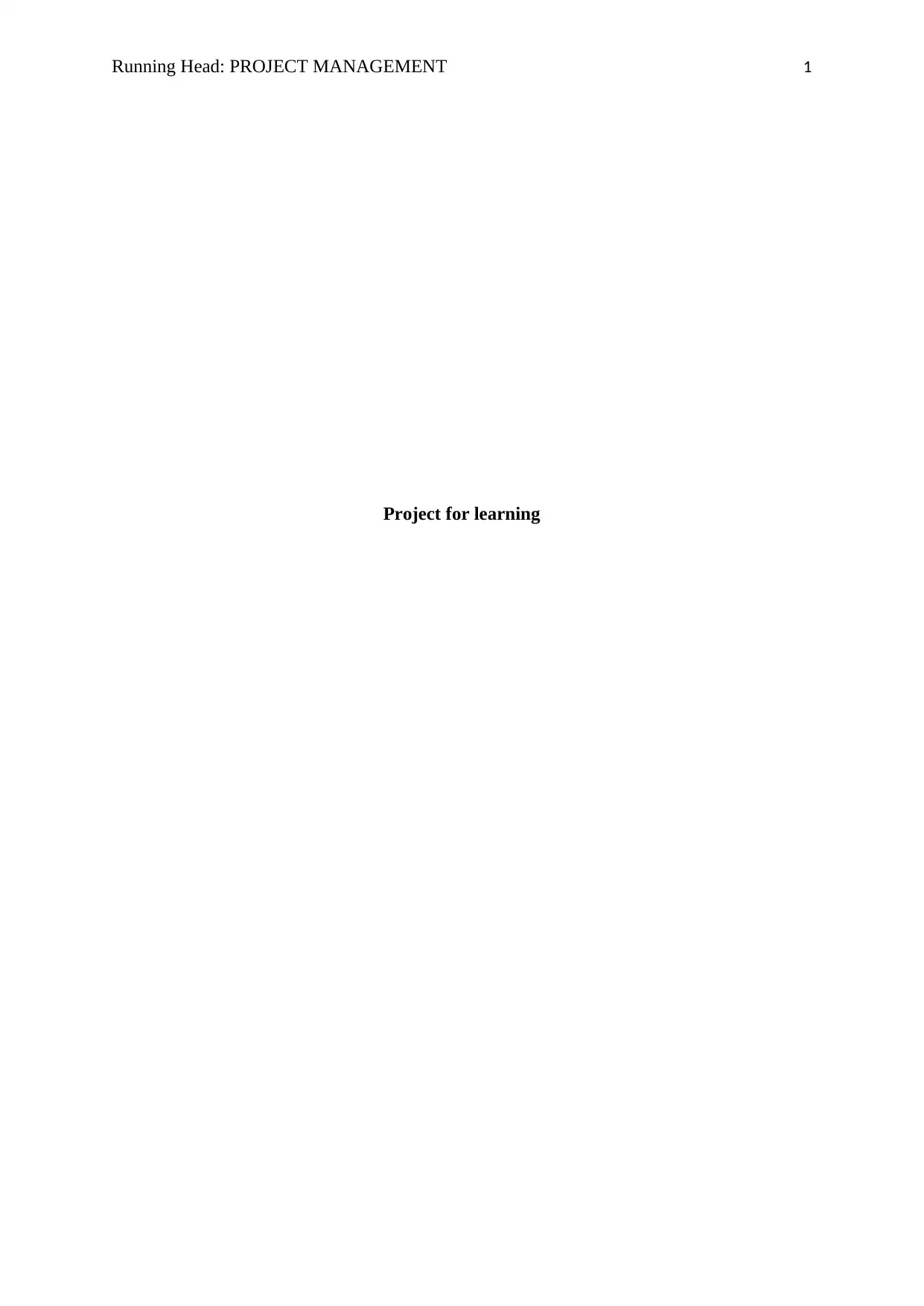
Running Head: PROJECT MANAGEMENT 1
Project for learning
Project for learning
Paraphrase This Document
Need a fresh take? Get an instant paraphrase of this document with our AI Paraphraser
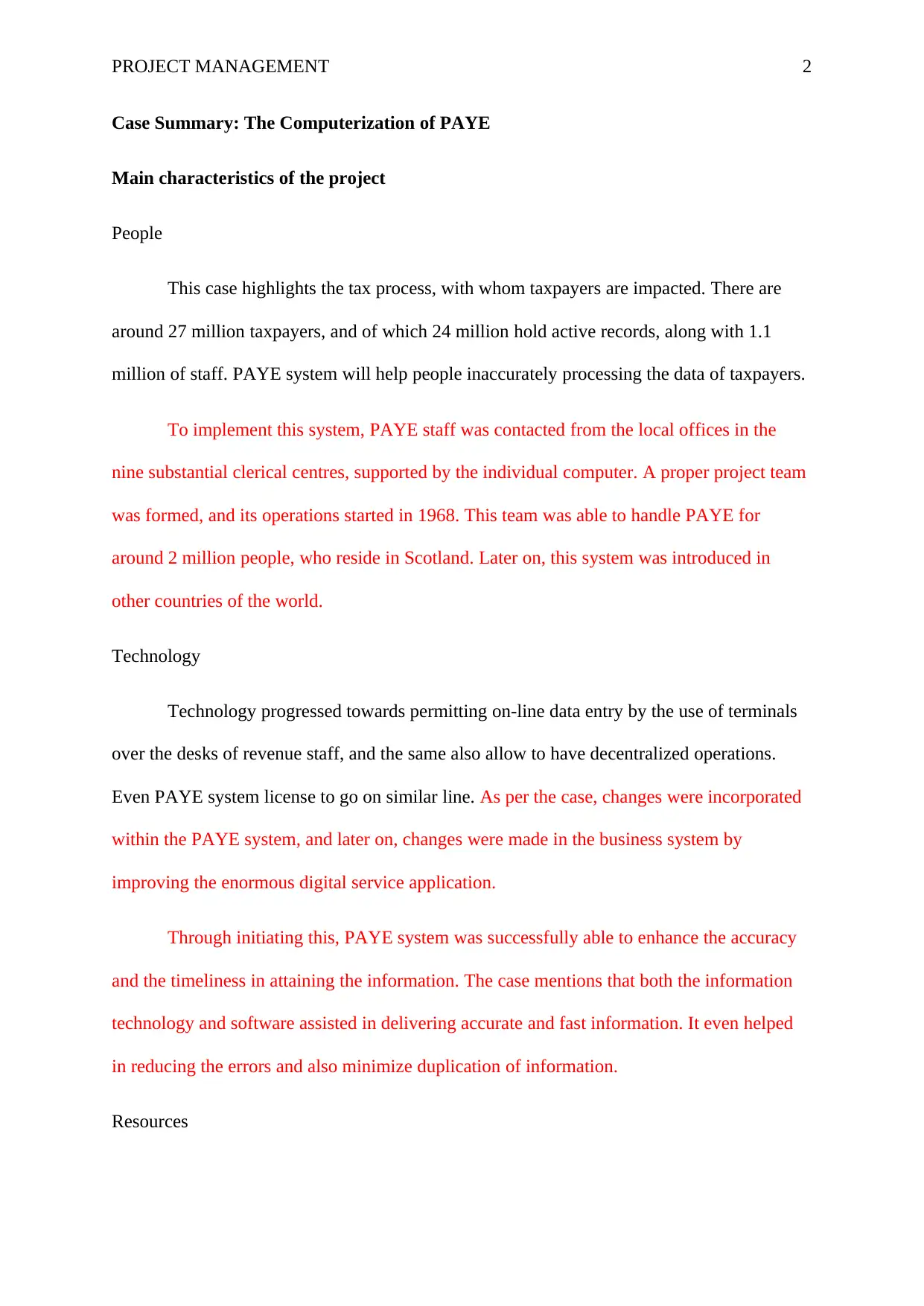
PROJECT MANAGEMENT 2
Case Summary: The Computerization of PAYE
Main characteristics of the project
People
This case highlights the tax process, with whom taxpayers are impacted. There are
around 27 million taxpayers, and of which 24 million hold active records, along with 1.1
million of staff. PAYE system will help people inaccurately processing the data of taxpayers.
To implement this system, PAYE staff was contacted from the local offices in the
nine substantial clerical centres, supported by the individual computer. A proper project team
was formed, and its operations started in 1968. This team was able to handle PAYE for
around 2 million people, who reside in Scotland. Later on, this system was introduced in
other countries of the world.
Technology
Technology progressed towards permitting on-line data entry by the use of terminals
over the desks of revenue staff, and the same also allow to have decentralized operations.
Even PAYE system license to go on similar line. As per the case, changes were incorporated
within the PAYE system, and later on, changes were made in the business system by
improving the enormous digital service application.
Through initiating this, PAYE system was successfully able to enhance the accuracy
and the timeliness in attaining the information. The case mentions that both the information
technology and software assisted in delivering accurate and fast information. It even helped
in reducing the errors and also minimize duplication of information.
Resources
Case Summary: The Computerization of PAYE
Main characteristics of the project
People
This case highlights the tax process, with whom taxpayers are impacted. There are
around 27 million taxpayers, and of which 24 million hold active records, along with 1.1
million of staff. PAYE system will help people inaccurately processing the data of taxpayers.
To implement this system, PAYE staff was contacted from the local offices in the
nine substantial clerical centres, supported by the individual computer. A proper project team
was formed, and its operations started in 1968. This team was able to handle PAYE for
around 2 million people, who reside in Scotland. Later on, this system was introduced in
other countries of the world.
Technology
Technology progressed towards permitting on-line data entry by the use of terminals
over the desks of revenue staff, and the same also allow to have decentralized operations.
Even PAYE system license to go on similar line. As per the case, changes were incorporated
within the PAYE system, and later on, changes were made in the business system by
improving the enormous digital service application.
Through initiating this, PAYE system was successfully able to enhance the accuracy
and the timeliness in attaining the information. The case mentions that both the information
technology and software assisted in delivering accurate and fast information. It even helped
in reducing the errors and also minimize duplication of information.
Resources
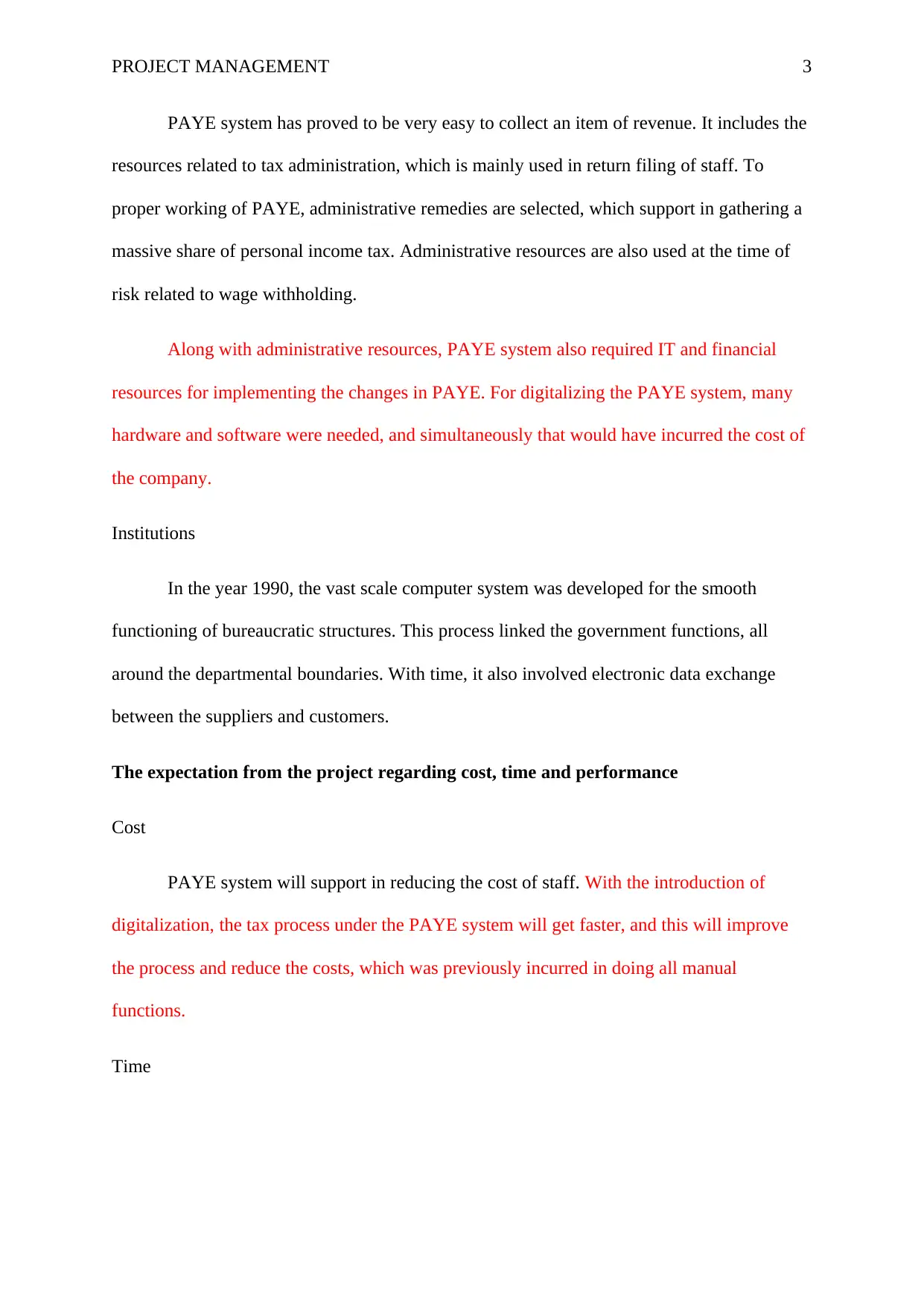
PROJECT MANAGEMENT 3
PAYE system has proved to be very easy to collect an item of revenue. It includes the
resources related to tax administration, which is mainly used in return filing of staff. To
proper working of PAYE, administrative remedies are selected, which support in gathering a
massive share of personal income tax. Administrative resources are also used at the time of
risk related to wage withholding.
Along with administrative resources, PAYE system also required IT and financial
resources for implementing the changes in PAYE. For digitalizing the PAYE system, many
hardware and software were needed, and simultaneously that would have incurred the cost of
the company.
Institutions
In the year 1990, the vast scale computer system was developed for the smooth
functioning of bureaucratic structures. This process linked the government functions, all
around the departmental boundaries. With time, it also involved electronic data exchange
between the suppliers and customers.
The expectation from the project regarding cost, time and performance
Cost
PAYE system will support in reducing the cost of staff. With the introduction of
digitalization, the tax process under the PAYE system will get faster, and this will improve
the process and reduce the costs, which was previously incurred in doing all manual
functions.
Time
PAYE system has proved to be very easy to collect an item of revenue. It includes the
resources related to tax administration, which is mainly used in return filing of staff. To
proper working of PAYE, administrative remedies are selected, which support in gathering a
massive share of personal income tax. Administrative resources are also used at the time of
risk related to wage withholding.
Along with administrative resources, PAYE system also required IT and financial
resources for implementing the changes in PAYE. For digitalizing the PAYE system, many
hardware and software were needed, and simultaneously that would have incurred the cost of
the company.
Institutions
In the year 1990, the vast scale computer system was developed for the smooth
functioning of bureaucratic structures. This process linked the government functions, all
around the departmental boundaries. With time, it also involved electronic data exchange
between the suppliers and customers.
The expectation from the project regarding cost, time and performance
Cost
PAYE system will support in reducing the cost of staff. With the introduction of
digitalization, the tax process under the PAYE system will get faster, and this will improve
the process and reduce the costs, which was previously incurred in doing all manual
functions.
Time
⊘ This is a preview!⊘
Do you want full access?
Subscribe today to unlock all pages.

Trusted by 1+ million students worldwide
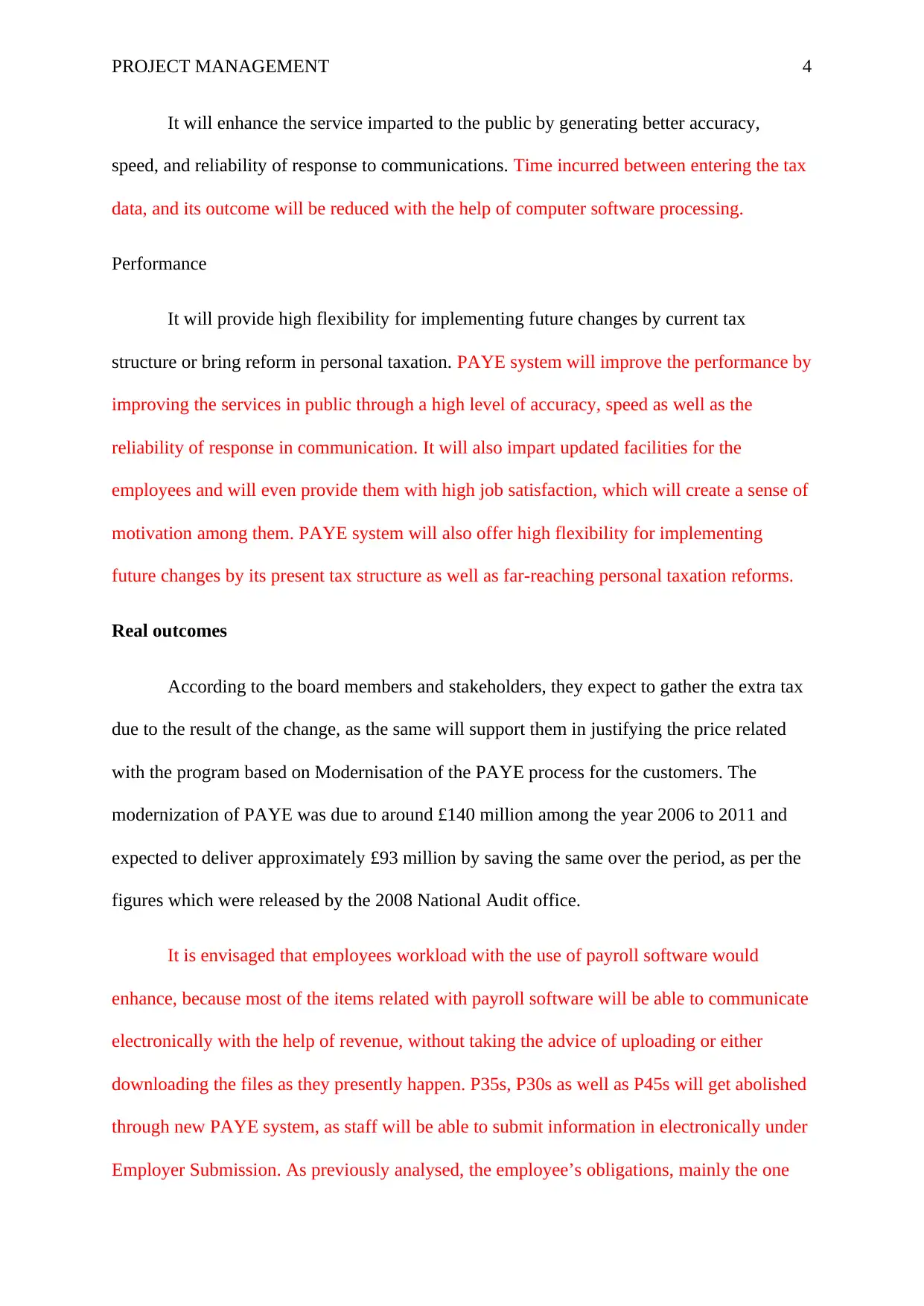
PROJECT MANAGEMENT 4
It will enhance the service imparted to the public by generating better accuracy,
speed, and reliability of response to communications. Time incurred between entering the tax
data, and its outcome will be reduced with the help of computer software processing.
Performance
It will provide high flexibility for implementing future changes by current tax
structure or bring reform in personal taxation. PAYE system will improve the performance by
improving the services in public through a high level of accuracy, speed as well as the
reliability of response in communication. It will also impart updated facilities for the
employees and will even provide them with high job satisfaction, which will create a sense of
motivation among them. PAYE system will also offer high flexibility for implementing
future changes by its present tax structure as well as far-reaching personal taxation reforms.
Real outcomes
According to the board members and stakeholders, they expect to gather the extra tax
due to the result of the change, as the same will support them in justifying the price related
with the program based on Modernisation of the PAYE process for the customers. The
modernization of PAYE was due to around £140 million among the year 2006 to 2011 and
expected to deliver approximately £93 million by saving the same over the period, as per the
figures which were released by the 2008 National Audit office.
It is envisaged that employees workload with the use of payroll software would
enhance, because most of the items related with payroll software will be able to communicate
electronically with the help of revenue, without taking the advice of uploading or either
downloading the files as they presently happen. P35s, P30s as well as P45s will get abolished
through new PAYE system, as staff will be able to submit information in electronically under
Employer Submission. As previously analysed, the employee’s obligations, mainly the one
It will enhance the service imparted to the public by generating better accuracy,
speed, and reliability of response to communications. Time incurred between entering the tax
data, and its outcome will be reduced with the help of computer software processing.
Performance
It will provide high flexibility for implementing future changes by current tax
structure or bring reform in personal taxation. PAYE system will improve the performance by
improving the services in public through a high level of accuracy, speed as well as the
reliability of response in communication. It will also impart updated facilities for the
employees and will even provide them with high job satisfaction, which will create a sense of
motivation among them. PAYE system will also offer high flexibility for implementing
future changes by its present tax structure as well as far-reaching personal taxation reforms.
Real outcomes
According to the board members and stakeholders, they expect to gather the extra tax
due to the result of the change, as the same will support them in justifying the price related
with the program based on Modernisation of the PAYE process for the customers. The
modernization of PAYE was due to around £140 million among the year 2006 to 2011 and
expected to deliver approximately £93 million by saving the same over the period, as per the
figures which were released by the 2008 National Audit office.
It is envisaged that employees workload with the use of payroll software would
enhance, because most of the items related with payroll software will be able to communicate
electronically with the help of revenue, without taking the advice of uploading or either
downloading the files as they presently happen. P35s, P30s as well as P45s will get abolished
through new PAYE system, as staff will be able to submit information in electronically under
Employer Submission. As previously analysed, the employee’s obligations, mainly the one
Paraphrase This Document
Need a fresh take? Get an instant paraphrase of this document with our AI Paraphraser
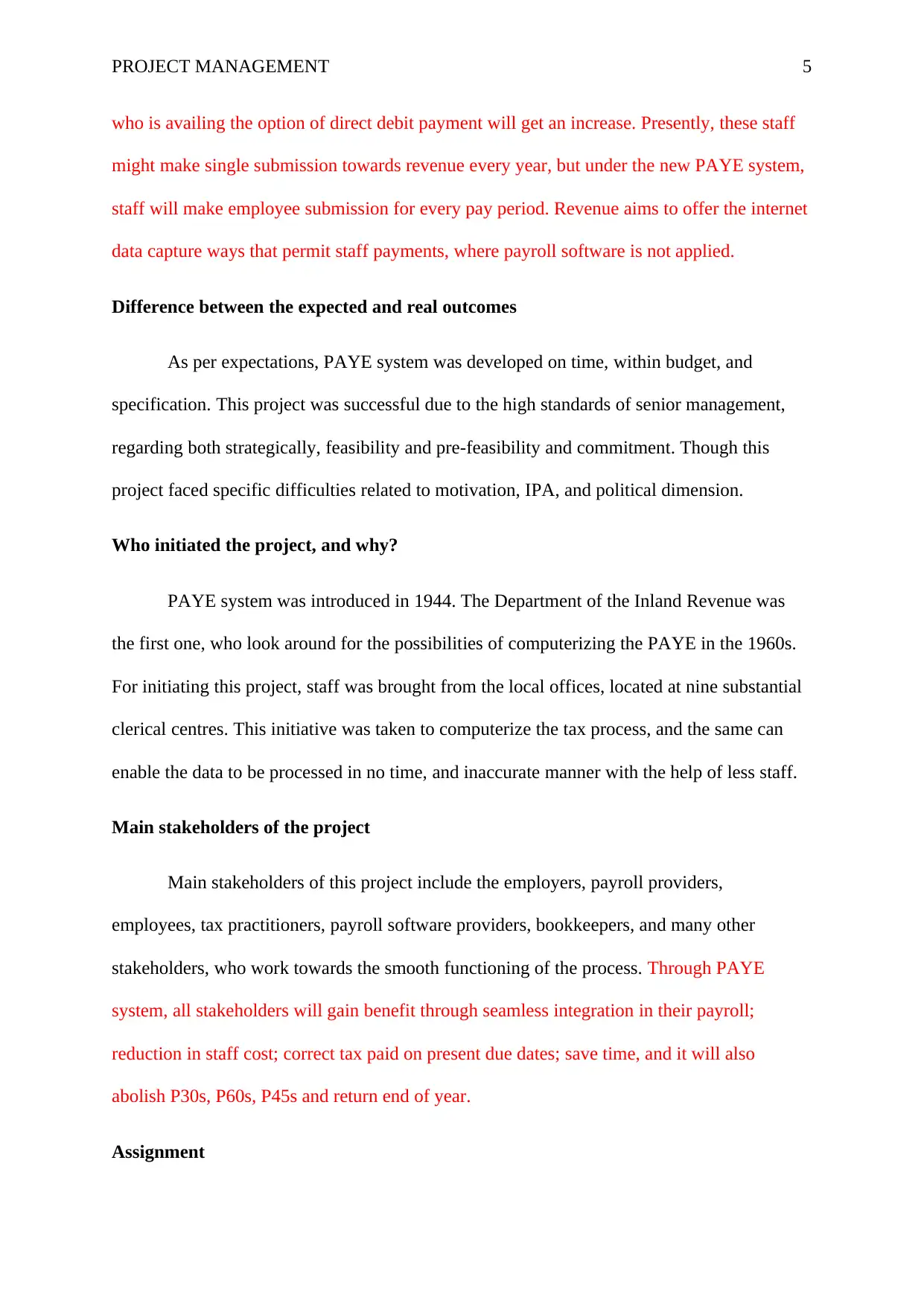
PROJECT MANAGEMENT 5
who is availing the option of direct debit payment will get an increase. Presently, these staff
might make single submission towards revenue every year, but under the new PAYE system,
staff will make employee submission for every pay period. Revenue aims to offer the internet
data capture ways that permit staff payments, where payroll software is not applied.
Difference between the expected and real outcomes
As per expectations, PAYE system was developed on time, within budget, and
specification. This project was successful due to the high standards of senior management,
regarding both strategically, feasibility and pre-feasibility and commitment. Though this
project faced specific difficulties related to motivation, IPA, and political dimension.
Who initiated the project, and why?
PAYE system was introduced in 1944. The Department of the Inland Revenue was
the first one, who look around for the possibilities of computerizing the PAYE in the 1960s.
For initiating this project, staff was brought from the local offices, located at nine substantial
clerical centres. This initiative was taken to computerize the tax process, and the same can
enable the data to be processed in no time, and inaccurate manner with the help of less staff.
Main stakeholders of the project
Main stakeholders of this project include the employers, payroll providers,
employees, tax practitioners, payroll software providers, bookkeepers, and many other
stakeholders, who work towards the smooth functioning of the process. Through PAYE
system, all stakeholders will gain benefit through seamless integration in their payroll;
reduction in staff cost; correct tax paid on present due dates; save time, and it will also
abolish P30s, P60s, P45s and return end of year.
Assignment
who is availing the option of direct debit payment will get an increase. Presently, these staff
might make single submission towards revenue every year, but under the new PAYE system,
staff will make employee submission for every pay period. Revenue aims to offer the internet
data capture ways that permit staff payments, where payroll software is not applied.
Difference between the expected and real outcomes
As per expectations, PAYE system was developed on time, within budget, and
specification. This project was successful due to the high standards of senior management,
regarding both strategically, feasibility and pre-feasibility and commitment. Though this
project faced specific difficulties related to motivation, IPA, and political dimension.
Who initiated the project, and why?
PAYE system was introduced in 1944. The Department of the Inland Revenue was
the first one, who look around for the possibilities of computerizing the PAYE in the 1960s.
For initiating this project, staff was brought from the local offices, located at nine substantial
clerical centres. This initiative was taken to computerize the tax process, and the same can
enable the data to be processed in no time, and inaccurate manner with the help of less staff.
Main stakeholders of the project
Main stakeholders of this project include the employers, payroll providers,
employees, tax practitioners, payroll software providers, bookkeepers, and many other
stakeholders, who work towards the smooth functioning of the process. Through PAYE
system, all stakeholders will gain benefit through seamless integration in their payroll;
reduction in staff cost; correct tax paid on present due dates; save time, and it will also
abolish P30s, P60s, P45s and return end of year.
Assignment
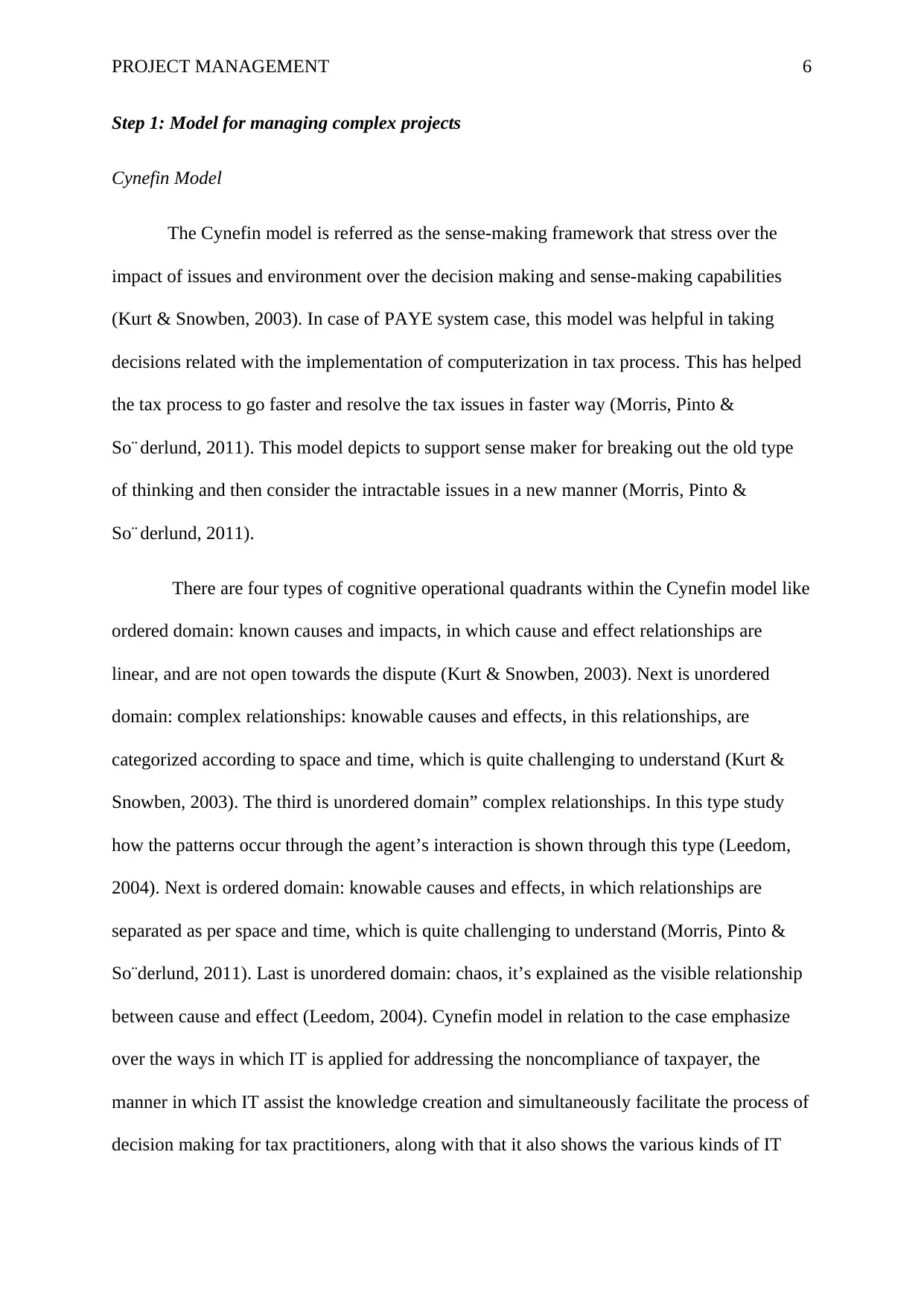
PROJECT MANAGEMENT 6
Step 1: Model for managing complex projects
Cynefin Model
The Cynefin model is referred as the sense-making framework that stress over the
impact of issues and environment over the decision making and sense-making capabilities
(Kurt & Snowben, 2003). In case of PAYE system case, this model was helpful in taking
decisions related with the implementation of computerization in tax process. This has helped
the tax process to go faster and resolve the tax issues in faster way (Morris, Pinto &
So¨ derlund, 2011). This model depicts to support sense maker for breaking out the old type
of thinking and then consider the intractable issues in a new manner (Morris, Pinto &
So¨ derlund, 2011).
There are four types of cognitive operational quadrants within the Cynefin model like
ordered domain: known causes and impacts, in which cause and effect relationships are
linear, and are not open towards the dispute (Kurt & Snowben, 2003). Next is unordered
domain: complex relationships: knowable causes and effects, in this relationships, are
categorized according to space and time, which is quite challenging to understand (Kurt &
Snowben, 2003). The third is unordered domain” complex relationships. In this type study
how the patterns occur through the agent’s interaction is shown through this type (Leedom,
2004). Next is ordered domain: knowable causes and effects, in which relationships are
separated as per space and time, which is quite challenging to understand (Morris, Pinto &
So¨derlund, 2011). Last is unordered domain: chaos, it’s explained as the visible relationship
between cause and effect (Leedom, 2004). Cynefin model in relation to the case emphasize
over the ways in which IT is applied for addressing the noncompliance of taxpayer, the
manner in which IT assist the knowledge creation and simultaneously facilitate the process of
decision making for tax practitioners, along with that it also shows the various kinds of IT
Step 1: Model for managing complex projects
Cynefin Model
The Cynefin model is referred as the sense-making framework that stress over the
impact of issues and environment over the decision making and sense-making capabilities
(Kurt & Snowben, 2003). In case of PAYE system case, this model was helpful in taking
decisions related with the implementation of computerization in tax process. This has helped
the tax process to go faster and resolve the tax issues in faster way (Morris, Pinto &
So¨ derlund, 2011). This model depicts to support sense maker for breaking out the old type
of thinking and then consider the intractable issues in a new manner (Morris, Pinto &
So¨ derlund, 2011).
There are four types of cognitive operational quadrants within the Cynefin model like
ordered domain: known causes and impacts, in which cause and effect relationships are
linear, and are not open towards the dispute (Kurt & Snowben, 2003). Next is unordered
domain: complex relationships: knowable causes and effects, in this relationships, are
categorized according to space and time, which is quite challenging to understand (Kurt &
Snowben, 2003). The third is unordered domain” complex relationships. In this type study
how the patterns occur through the agent’s interaction is shown through this type (Leedom,
2004). Next is ordered domain: knowable causes and effects, in which relationships are
separated as per space and time, which is quite challenging to understand (Morris, Pinto &
So¨derlund, 2011). Last is unordered domain: chaos, it’s explained as the visible relationship
between cause and effect (Leedom, 2004). Cynefin model in relation to the case emphasize
over the ways in which IT is applied for addressing the noncompliance of taxpayer, the
manner in which IT assist the knowledge creation and simultaneously facilitate the process of
decision making for tax practitioners, along with that it also shows the various kinds of IT
⊘ This is a preview!⊘
Do you want full access?
Subscribe today to unlock all pages.

Trusted by 1+ million students worldwide
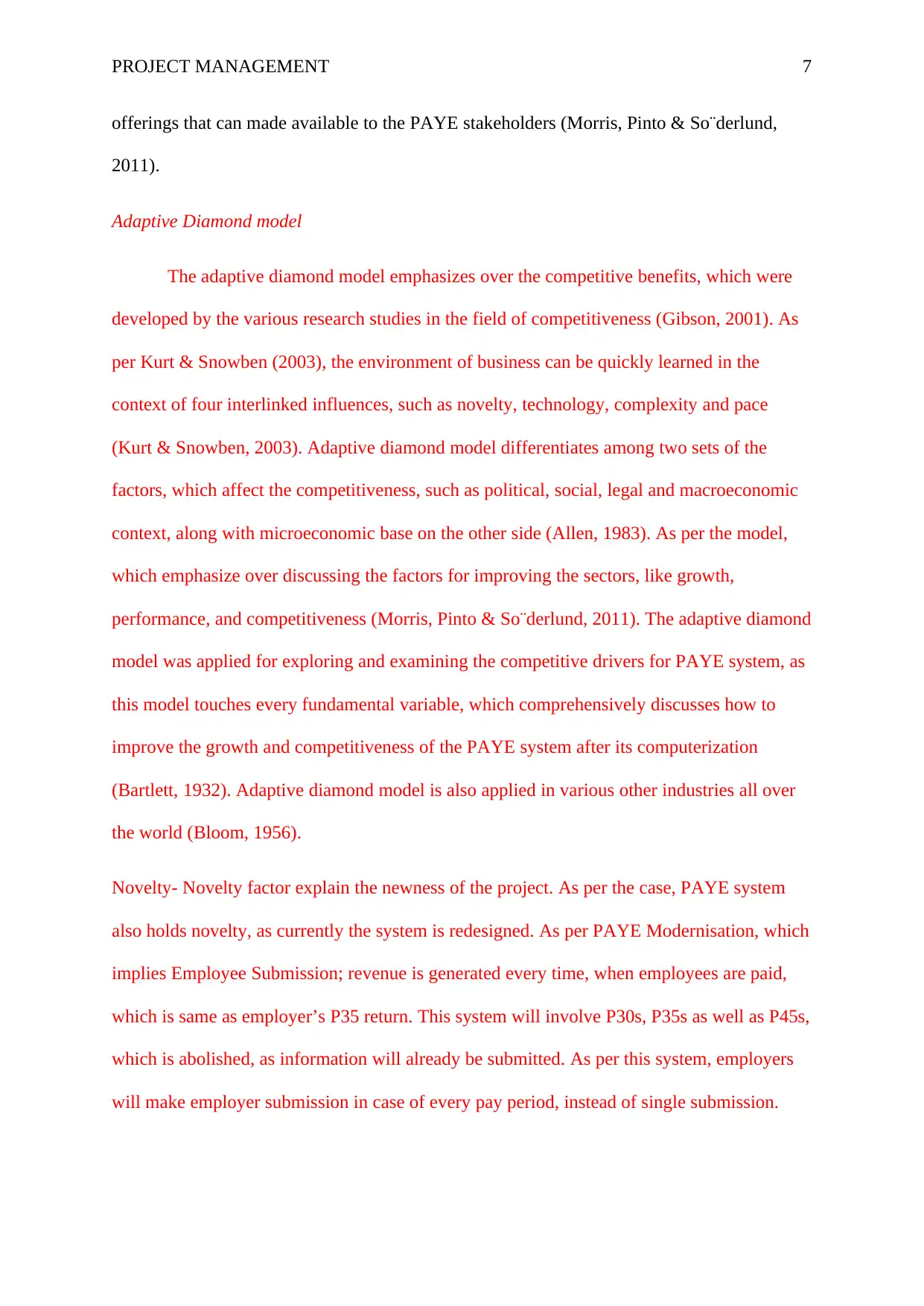
PROJECT MANAGEMENT 7
offerings that can made available to the PAYE stakeholders (Morris, Pinto & So¨derlund,
2011).
Adaptive Diamond model
The adaptive diamond model emphasizes over the competitive benefits, which were
developed by the various research studies in the field of competitiveness (Gibson, 2001). As
per Kurt & Snowben (2003), the environment of business can be quickly learned in the
context of four interlinked influences, such as novelty, technology, complexity and pace
(Kurt & Snowben, 2003). Adaptive diamond model differentiates among two sets of the
factors, which affect the competitiveness, such as political, social, legal and macroeconomic
context, along with microeconomic base on the other side (Allen, 1983). As per the model,
which emphasize over discussing the factors for improving the sectors, like growth,
performance, and competitiveness (Morris, Pinto & So¨derlund, 2011). The adaptive diamond
model was applied for exploring and examining the competitive drivers for PAYE system, as
this model touches every fundamental variable, which comprehensively discusses how to
improve the growth and competitiveness of the PAYE system after its computerization
(Bartlett, 1932). Adaptive diamond model is also applied in various other industries all over
the world (Bloom, 1956).
Novelty- Novelty factor explain the newness of the project. As per the case, PAYE system
also holds novelty, as currently the system is redesigned. As per PAYE Modernisation, which
implies Employee Submission; revenue is generated every time, when employees are paid,
which is same as employer’s P35 return. This system will involve P30s, P35s as well as P45s,
which is abolished, as information will already be submitted. As per this system, employers
will make employer submission in case of every pay period, instead of single submission.
offerings that can made available to the PAYE stakeholders (Morris, Pinto & So¨derlund,
2011).
Adaptive Diamond model
The adaptive diamond model emphasizes over the competitive benefits, which were
developed by the various research studies in the field of competitiveness (Gibson, 2001). As
per Kurt & Snowben (2003), the environment of business can be quickly learned in the
context of four interlinked influences, such as novelty, technology, complexity and pace
(Kurt & Snowben, 2003). Adaptive diamond model differentiates among two sets of the
factors, which affect the competitiveness, such as political, social, legal and macroeconomic
context, along with microeconomic base on the other side (Allen, 1983). As per the model,
which emphasize over discussing the factors for improving the sectors, like growth,
performance, and competitiveness (Morris, Pinto & So¨derlund, 2011). The adaptive diamond
model was applied for exploring and examining the competitive drivers for PAYE system, as
this model touches every fundamental variable, which comprehensively discusses how to
improve the growth and competitiveness of the PAYE system after its computerization
(Bartlett, 1932). Adaptive diamond model is also applied in various other industries all over
the world (Bloom, 1956).
Novelty- Novelty factor explain the newness of the project. As per the case, PAYE system
also holds novelty, as currently the system is redesigned. As per PAYE Modernisation, which
implies Employee Submission; revenue is generated every time, when employees are paid,
which is same as employer’s P35 return. This system will involve P30s, P35s as well as P45s,
which is abolished, as information will already be submitted. As per this system, employers
will make employer submission in case of every pay period, instead of single submission.
Paraphrase This Document
Need a fresh take? Get an instant paraphrase of this document with our AI Paraphraser
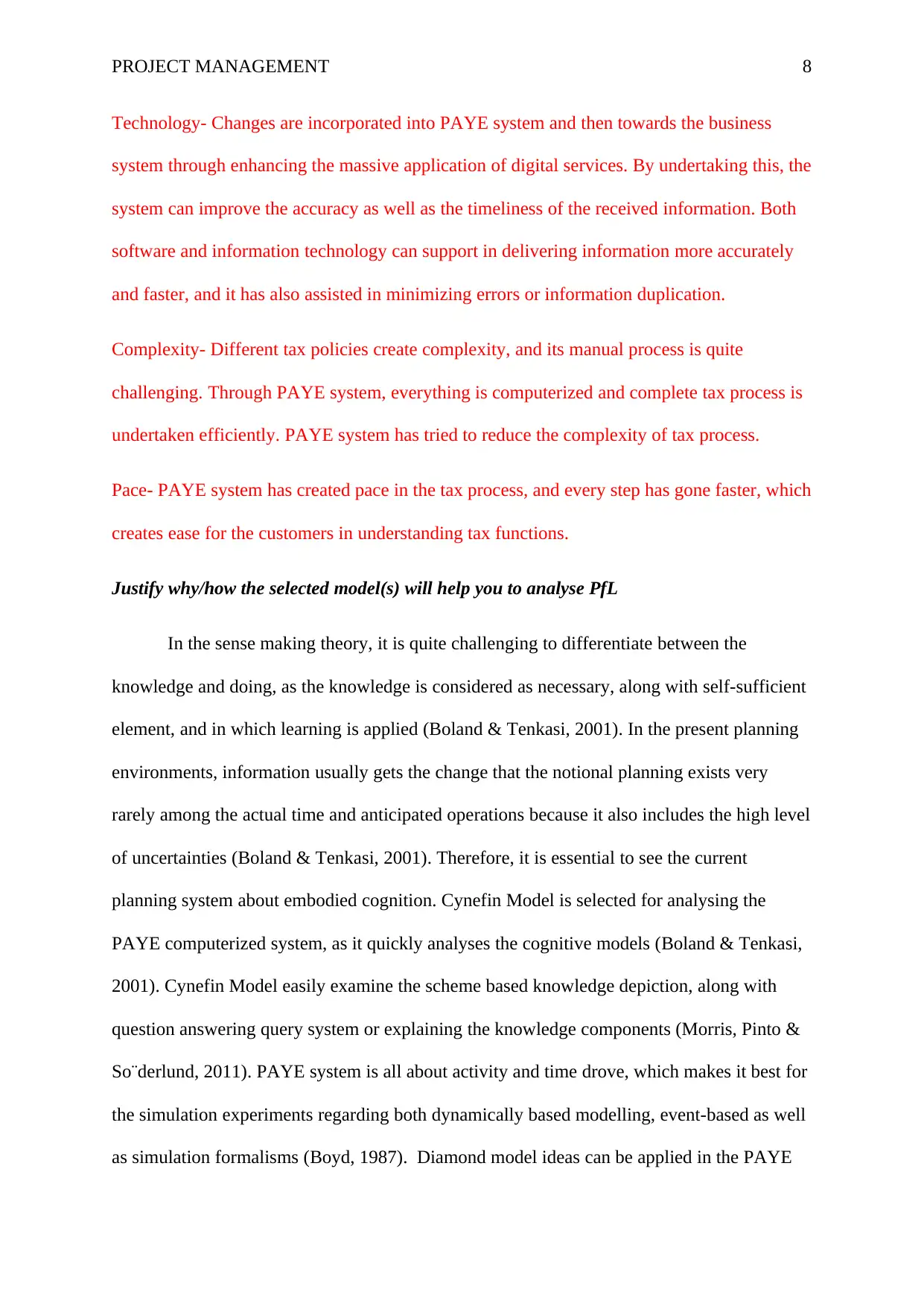
PROJECT MANAGEMENT 8
Technology- Changes are incorporated into PAYE system and then towards the business
system through enhancing the massive application of digital services. By undertaking this, the
system can improve the accuracy as well as the timeliness of the received information. Both
software and information technology can support in delivering information more accurately
and faster, and it has also assisted in minimizing errors or information duplication.
Complexity- Different tax policies create complexity, and its manual process is quite
challenging. Through PAYE system, everything is computerized and complete tax process is
undertaken efficiently. PAYE system has tried to reduce the complexity of tax process.
Pace- PAYE system has created pace in the tax process, and every step has gone faster, which
creates ease for the customers in understanding tax functions.
Justify why/how the selected model(s) will help you to analyse PfL
In the sense making theory, it is quite challenging to differentiate between the
knowledge and doing, as the knowledge is considered as necessary, along with self-sufficient
element, and in which learning is applied (Boland & Tenkasi, 2001). In the present planning
environments, information usually gets the change that the notional planning exists very
rarely among the actual time and anticipated operations because it also includes the high level
of uncertainties (Boland & Tenkasi, 2001). Therefore, it is essential to see the current
planning system about embodied cognition. Cynefin Model is selected for analysing the
PAYE computerized system, as it quickly analyses the cognitive models (Boland & Tenkasi,
2001). Cynefin Model easily examine the scheme based knowledge depiction, along with
question answering query system or explaining the knowledge components (Morris, Pinto &
So¨derlund, 2011). PAYE system is all about activity and time drove, which makes it best for
the simulation experiments regarding both dynamically based modelling, event-based as well
as simulation formalisms (Boyd, 1987). Diamond model ideas can be applied in the PAYE
Technology- Changes are incorporated into PAYE system and then towards the business
system through enhancing the massive application of digital services. By undertaking this, the
system can improve the accuracy as well as the timeliness of the received information. Both
software and information technology can support in delivering information more accurately
and faster, and it has also assisted in minimizing errors or information duplication.
Complexity- Different tax policies create complexity, and its manual process is quite
challenging. Through PAYE system, everything is computerized and complete tax process is
undertaken efficiently. PAYE system has tried to reduce the complexity of tax process.
Pace- PAYE system has created pace in the tax process, and every step has gone faster, which
creates ease for the customers in understanding tax functions.
Justify why/how the selected model(s) will help you to analyse PfL
In the sense making theory, it is quite challenging to differentiate between the
knowledge and doing, as the knowledge is considered as necessary, along with self-sufficient
element, and in which learning is applied (Boland & Tenkasi, 2001). In the present planning
environments, information usually gets the change that the notional planning exists very
rarely among the actual time and anticipated operations because it also includes the high level
of uncertainties (Boland & Tenkasi, 2001). Therefore, it is essential to see the current
planning system about embodied cognition. Cynefin Model is selected for analysing the
PAYE computerized system, as it quickly analyses the cognitive models (Boland & Tenkasi,
2001). Cynefin Model easily examine the scheme based knowledge depiction, along with
question answering query system or explaining the knowledge components (Morris, Pinto &
So¨derlund, 2011). PAYE system is all about activity and time drove, which makes it best for
the simulation experiments regarding both dynamically based modelling, event-based as well
as simulation formalisms (Boyd, 1987). Diamond model ideas can be applied in the PAYE
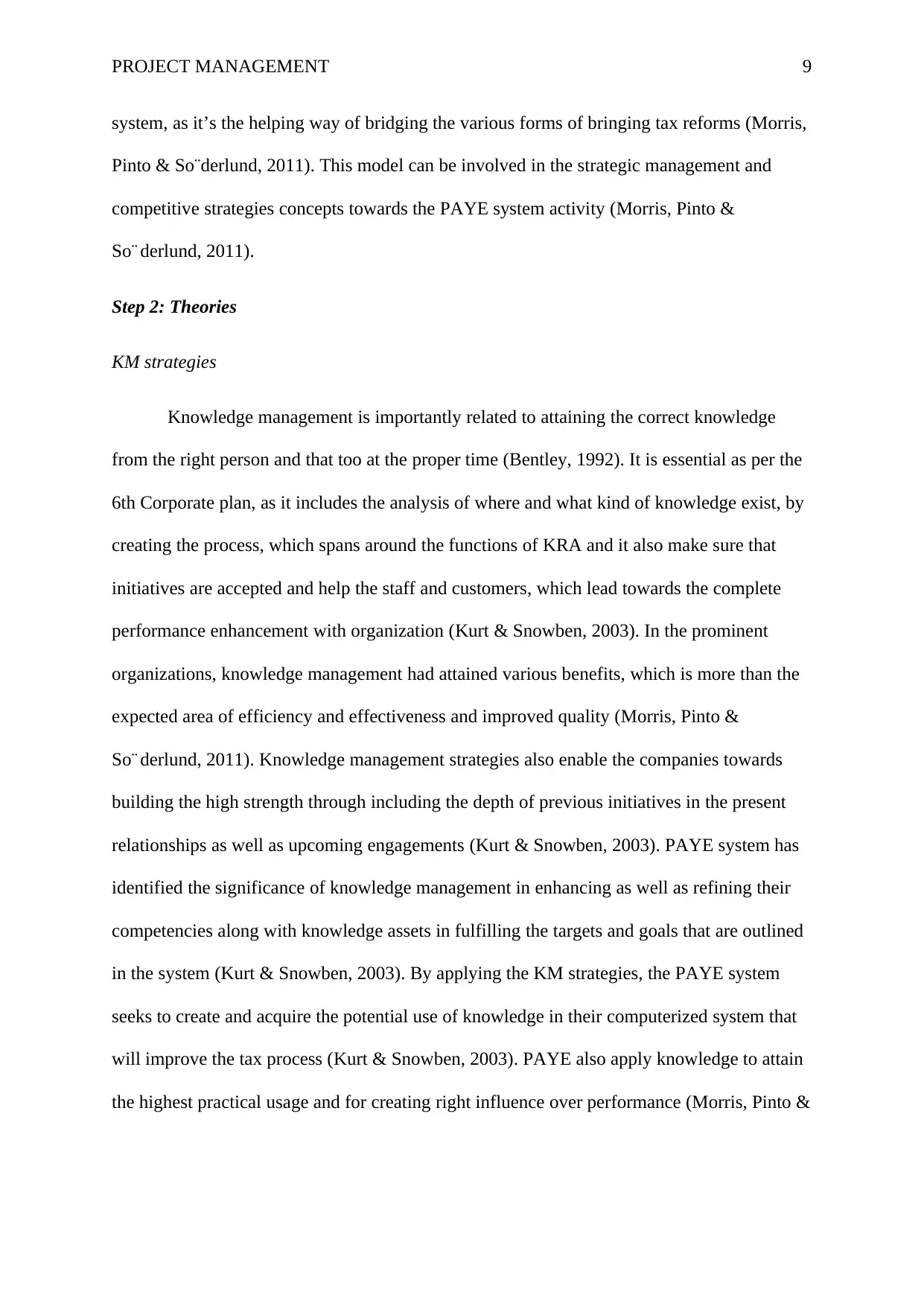
PROJECT MANAGEMENT 9
system, as it’s the helping way of bridging the various forms of bringing tax reforms (Morris,
Pinto & So¨derlund, 2011). This model can be involved in the strategic management and
competitive strategies concepts towards the PAYE system activity (Morris, Pinto &
So¨ derlund, 2011).
Step 2: Theories
KM strategies
Knowledge management is importantly related to attaining the correct knowledge
from the right person and that too at the proper time (Bentley, 1992). It is essential as per the
6th Corporate plan, as it includes the analysis of where and what kind of knowledge exist, by
creating the process, which spans around the functions of KRA and it also make sure that
initiatives are accepted and help the staff and customers, which lead towards the complete
performance enhancement with organization (Kurt & Snowben, 2003). In the prominent
organizations, knowledge management had attained various benefits, which is more than the
expected area of efficiency and effectiveness and improved quality (Morris, Pinto &
So¨ derlund, 2011). Knowledge management strategies also enable the companies towards
building the high strength through including the depth of previous initiatives in the present
relationships as well as upcoming engagements (Kurt & Snowben, 2003). PAYE system has
identified the significance of knowledge management in enhancing as well as refining their
competencies along with knowledge assets in fulfilling the targets and goals that are outlined
in the system (Kurt & Snowben, 2003). By applying the KM strategies, the PAYE system
seeks to create and acquire the potential use of knowledge in their computerized system that
will improve the tax process (Kurt & Snowben, 2003). PAYE also apply knowledge to attain
the highest practical usage and for creating right influence over performance (Morris, Pinto &
system, as it’s the helping way of bridging the various forms of bringing tax reforms (Morris,
Pinto & So¨derlund, 2011). This model can be involved in the strategic management and
competitive strategies concepts towards the PAYE system activity (Morris, Pinto &
So¨ derlund, 2011).
Step 2: Theories
KM strategies
Knowledge management is importantly related to attaining the correct knowledge
from the right person and that too at the proper time (Bentley, 1992). It is essential as per the
6th Corporate plan, as it includes the analysis of where and what kind of knowledge exist, by
creating the process, which spans around the functions of KRA and it also make sure that
initiatives are accepted and help the staff and customers, which lead towards the complete
performance enhancement with organization (Kurt & Snowben, 2003). In the prominent
organizations, knowledge management had attained various benefits, which is more than the
expected area of efficiency and effectiveness and improved quality (Morris, Pinto &
So¨ derlund, 2011). Knowledge management strategies also enable the companies towards
building the high strength through including the depth of previous initiatives in the present
relationships as well as upcoming engagements (Kurt & Snowben, 2003). PAYE system has
identified the significance of knowledge management in enhancing as well as refining their
competencies along with knowledge assets in fulfilling the targets and goals that are outlined
in the system (Kurt & Snowben, 2003). By applying the KM strategies, the PAYE system
seeks to create and acquire the potential use of knowledge in their computerized system that
will improve the tax process (Kurt & Snowben, 2003). PAYE also apply knowledge to attain
the highest practical usage and for creating right influence over performance (Morris, Pinto &
⊘ This is a preview!⊘
Do you want full access?
Subscribe today to unlock all pages.

Trusted by 1+ million students worldwide
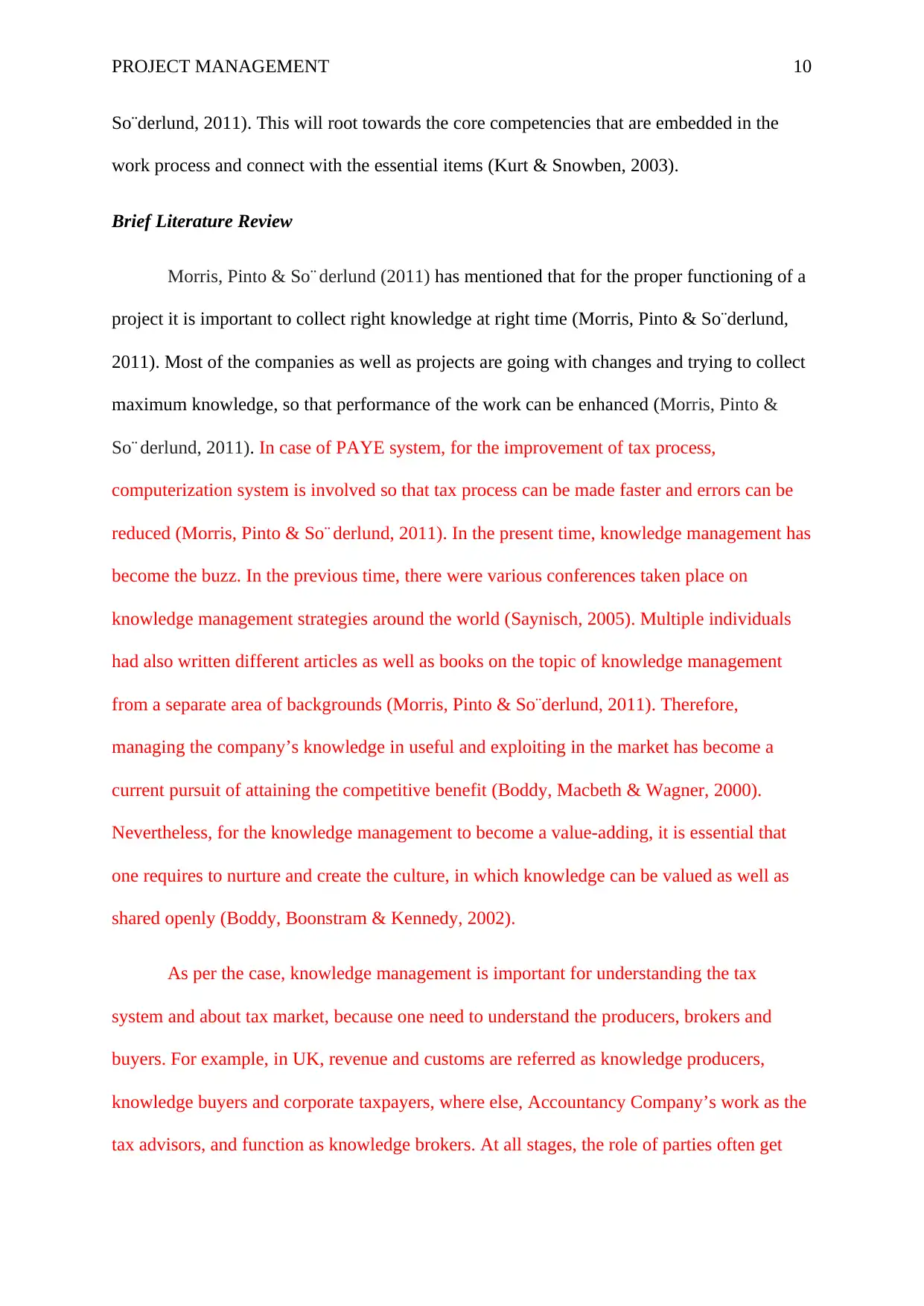
PROJECT MANAGEMENT 10
So¨derlund, 2011). This will root towards the core competencies that are embedded in the
work process and connect with the essential items (Kurt & Snowben, 2003).
Brief Literature Review
Morris, Pinto & So¨ derlund (2011) has mentioned that for the proper functioning of a
project it is important to collect right knowledge at right time (Morris, Pinto & So¨derlund,
2011). Most of the companies as well as projects are going with changes and trying to collect
maximum knowledge, so that performance of the work can be enhanced (Morris, Pinto &
So¨ derlund, 2011). In case of PAYE system, for the improvement of tax process,
computerization system is involved so that tax process can be made faster and errors can be
reduced (Morris, Pinto & So¨ derlund, 2011). In the present time, knowledge management has
become the buzz. In the previous time, there were various conferences taken place on
knowledge management strategies around the world (Saynisch, 2005). Multiple individuals
had also written different articles as well as books on the topic of knowledge management
from a separate area of backgrounds (Morris, Pinto & So¨derlund, 2011). Therefore,
managing the company’s knowledge in useful and exploiting in the market has become a
current pursuit of attaining the competitive benefit (Boddy, Macbeth & Wagner, 2000).
Nevertheless, for the knowledge management to become a value-adding, it is essential that
one requires to nurture and create the culture, in which knowledge can be valued as well as
shared openly (Boddy, Boonstram & Kennedy, 2002).
As per the case, knowledge management is important for understanding the tax
system and about tax market, because one need to understand the producers, brokers and
buyers. For example, in UK, revenue and customs are referred as knowledge producers,
knowledge buyers and corporate taxpayers, where else, Accountancy Company’s work as the
tax advisors, and function as knowledge brokers. At all stages, the role of parties often get
So¨derlund, 2011). This will root towards the core competencies that are embedded in the
work process and connect with the essential items (Kurt & Snowben, 2003).
Brief Literature Review
Morris, Pinto & So¨ derlund (2011) has mentioned that for the proper functioning of a
project it is important to collect right knowledge at right time (Morris, Pinto & So¨derlund,
2011). Most of the companies as well as projects are going with changes and trying to collect
maximum knowledge, so that performance of the work can be enhanced (Morris, Pinto &
So¨ derlund, 2011). In case of PAYE system, for the improvement of tax process,
computerization system is involved so that tax process can be made faster and errors can be
reduced (Morris, Pinto & So¨ derlund, 2011). In the present time, knowledge management has
become the buzz. In the previous time, there were various conferences taken place on
knowledge management strategies around the world (Saynisch, 2005). Multiple individuals
had also written different articles as well as books on the topic of knowledge management
from a separate area of backgrounds (Morris, Pinto & So¨derlund, 2011). Therefore,
managing the company’s knowledge in useful and exploiting in the market has become a
current pursuit of attaining the competitive benefit (Boddy, Macbeth & Wagner, 2000).
Nevertheless, for the knowledge management to become a value-adding, it is essential that
one requires to nurture and create the culture, in which knowledge can be valued as well as
shared openly (Boddy, Boonstram & Kennedy, 2002).
As per the case, knowledge management is important for understanding the tax
system and about tax market, because one need to understand the producers, brokers and
buyers. For example, in UK, revenue and customs are referred as knowledge producers,
knowledge buyers and corporate taxpayers, where else, Accountancy Company’s work as the
tax advisors, and function as knowledge brokers. At all stages, the role of parties often get
Paraphrase This Document
Need a fresh take? Get an instant paraphrase of this document with our AI Paraphraser
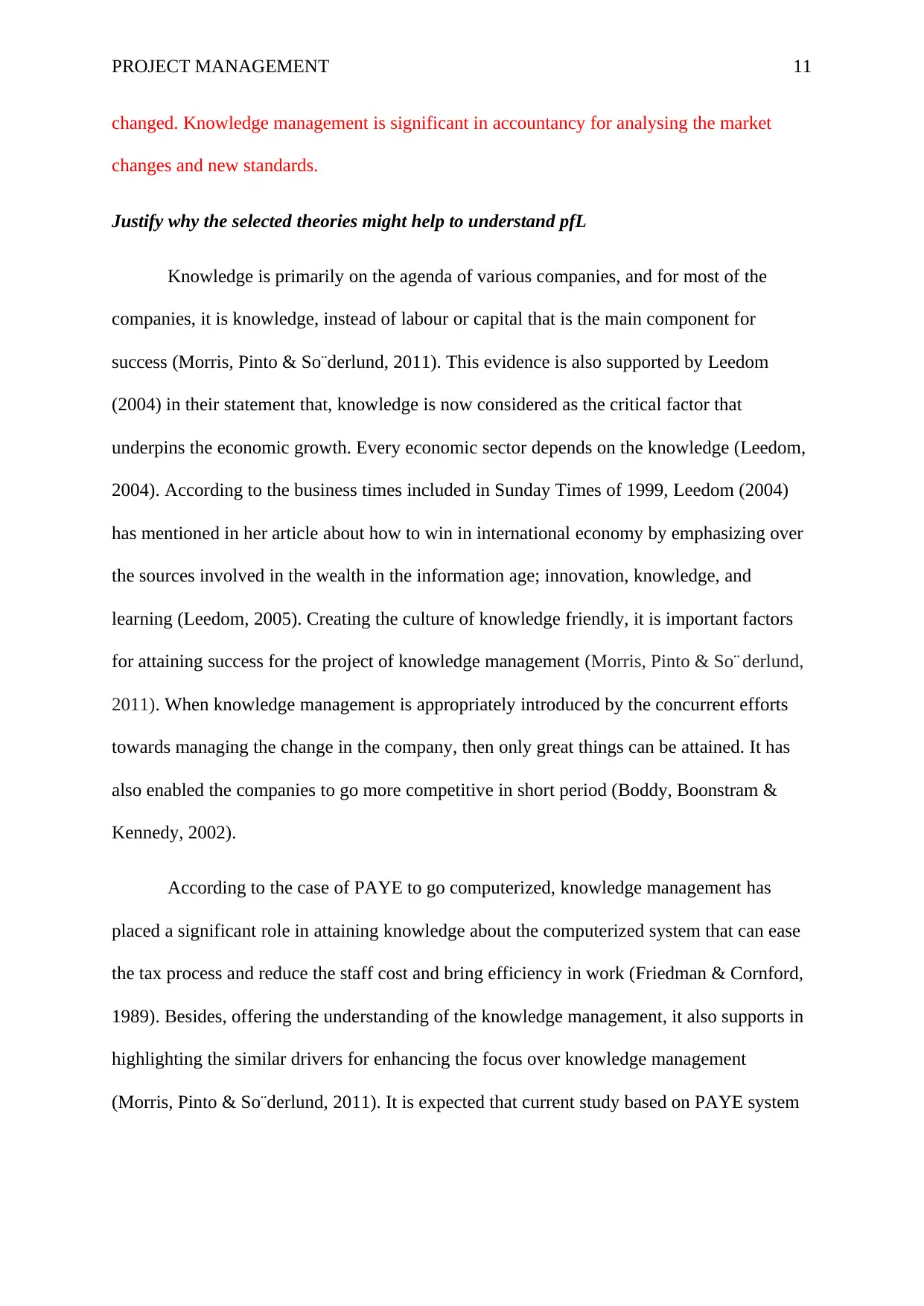
PROJECT MANAGEMENT 11
changed. Knowledge management is significant in accountancy for analysing the market
changes and new standards.
Justify why the selected theories might help to understand pfL
Knowledge is primarily on the agenda of various companies, and for most of the
companies, it is knowledge, instead of labour or capital that is the main component for
success (Morris, Pinto & So¨derlund, 2011). This evidence is also supported by Leedom
(2004) in their statement that, knowledge is now considered as the critical factor that
underpins the economic growth. Every economic sector depends on the knowledge (Leedom,
2004). According to the business times included in Sunday Times of 1999, Leedom (2004)
has mentioned in her article about how to win in international economy by emphasizing over
the sources involved in the wealth in the information age; innovation, knowledge, and
learning (Leedom, 2005). Creating the culture of knowledge friendly, it is important factors
for attaining success for the project of knowledge management (Morris, Pinto & So¨ derlund,
2011). When knowledge management is appropriately introduced by the concurrent efforts
towards managing the change in the company, then only great things can be attained. It has
also enabled the companies to go more competitive in short period (Boddy, Boonstram &
Kennedy, 2002).
According to the case of PAYE to go computerized, knowledge management has
placed a significant role in attaining knowledge about the computerized system that can ease
the tax process and reduce the staff cost and bring efficiency in work (Friedman & Cornford,
1989). Besides, offering the understanding of the knowledge management, it also supports in
highlighting the similar drivers for enhancing the focus over knowledge management
(Morris, Pinto & So¨derlund, 2011). It is expected that current study based on PAYE system
changed. Knowledge management is significant in accountancy for analysing the market
changes and new standards.
Justify why the selected theories might help to understand pfL
Knowledge is primarily on the agenda of various companies, and for most of the
companies, it is knowledge, instead of labour or capital that is the main component for
success (Morris, Pinto & So¨derlund, 2011). This evidence is also supported by Leedom
(2004) in their statement that, knowledge is now considered as the critical factor that
underpins the economic growth. Every economic sector depends on the knowledge (Leedom,
2004). According to the business times included in Sunday Times of 1999, Leedom (2004)
has mentioned in her article about how to win in international economy by emphasizing over
the sources involved in the wealth in the information age; innovation, knowledge, and
learning (Leedom, 2005). Creating the culture of knowledge friendly, it is important factors
for attaining success for the project of knowledge management (Morris, Pinto & So¨ derlund,
2011). When knowledge management is appropriately introduced by the concurrent efforts
towards managing the change in the company, then only great things can be attained. It has
also enabled the companies to go more competitive in short period (Boddy, Boonstram &
Kennedy, 2002).
According to the case of PAYE to go computerized, knowledge management has
placed a significant role in attaining knowledge about the computerized system that can ease
the tax process and reduce the staff cost and bring efficiency in work (Friedman & Cornford,
1989). Besides, offering the understanding of the knowledge management, it also supports in
highlighting the similar drivers for enhancing the focus over knowledge management
(Morris, Pinto & So¨derlund, 2011). It is expected that current study based on PAYE system
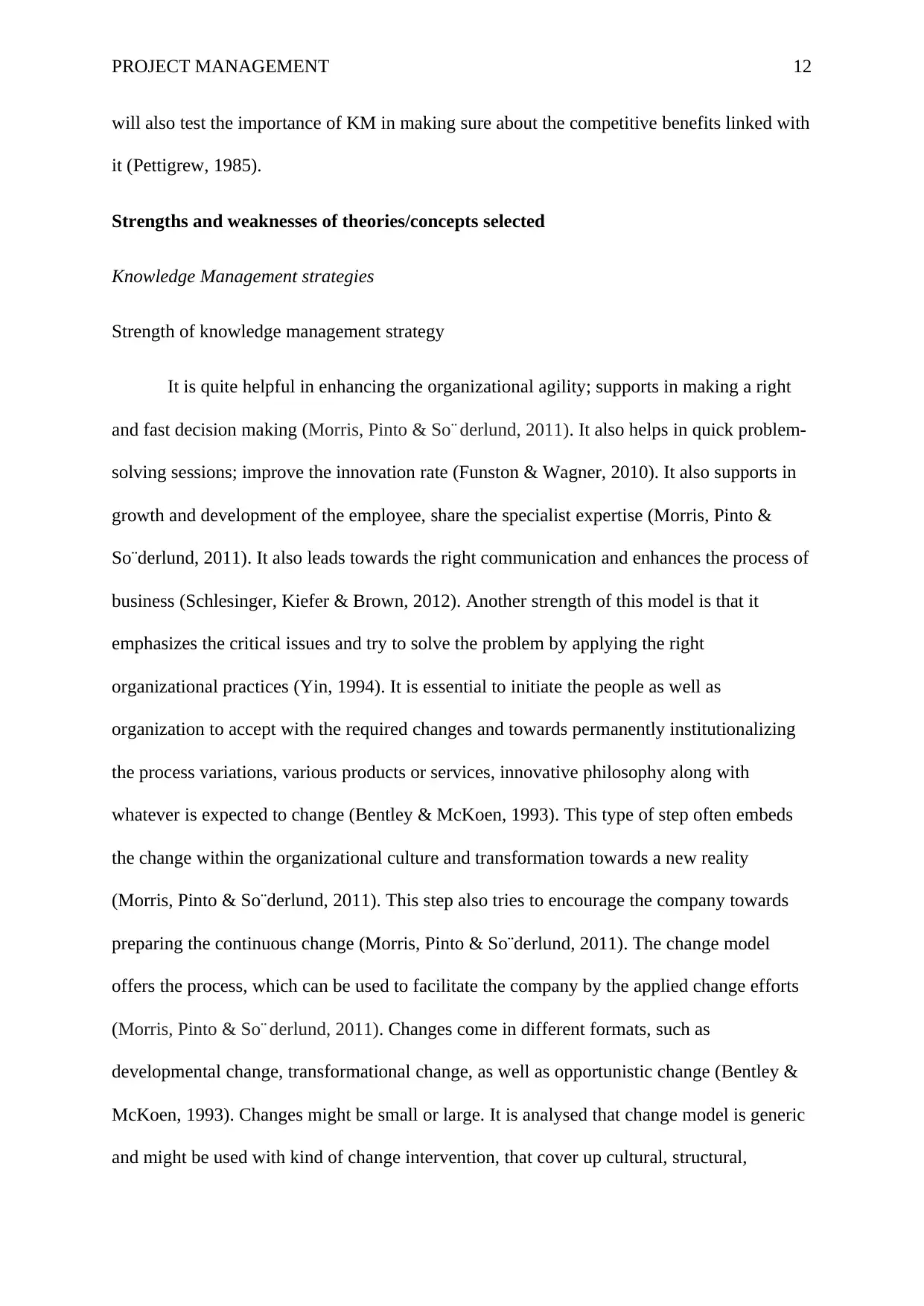
PROJECT MANAGEMENT 12
will also test the importance of KM in making sure about the competitive benefits linked with
it (Pettigrew, 1985).
Strengths and weaknesses of theories/concepts selected
Knowledge Management strategies
Strength of knowledge management strategy
It is quite helpful in enhancing the organizational agility; supports in making a right
and fast decision making (Morris, Pinto & So¨ derlund, 2011). It also helps in quick problem-
solving sessions; improve the innovation rate (Funston & Wagner, 2010). It also supports in
growth and development of the employee, share the specialist expertise (Morris, Pinto &
So¨derlund, 2011). It also leads towards the right communication and enhances the process of
business (Schlesinger, Kiefer & Brown, 2012). Another strength of this model is that it
emphasizes the critical issues and try to solve the problem by applying the right
organizational practices (Yin, 1994). It is essential to initiate the people as well as
organization to accept with the required changes and towards permanently institutionalizing
the process variations, various products or services, innovative philosophy along with
whatever is expected to change (Bentley & McKoen, 1993). This type of step often embeds
the change within the organizational culture and transformation towards a new reality
(Morris, Pinto & So¨derlund, 2011). This step also tries to encourage the company towards
preparing the continuous change (Morris, Pinto & So¨derlund, 2011). The change model
offers the process, which can be used to facilitate the company by the applied change efforts
(Morris, Pinto & So¨ derlund, 2011). Changes come in different formats, such as
developmental change, transformational change, as well as opportunistic change (Bentley &
McKoen, 1993). Changes might be small or large. It is analysed that change model is generic
and might be used with kind of change intervention, that cover up cultural, structural,
will also test the importance of KM in making sure about the competitive benefits linked with
it (Pettigrew, 1985).
Strengths and weaknesses of theories/concepts selected
Knowledge Management strategies
Strength of knowledge management strategy
It is quite helpful in enhancing the organizational agility; supports in making a right
and fast decision making (Morris, Pinto & So¨ derlund, 2011). It also helps in quick problem-
solving sessions; improve the innovation rate (Funston & Wagner, 2010). It also supports in
growth and development of the employee, share the specialist expertise (Morris, Pinto &
So¨derlund, 2011). It also leads towards the right communication and enhances the process of
business (Schlesinger, Kiefer & Brown, 2012). Another strength of this model is that it
emphasizes the critical issues and try to solve the problem by applying the right
organizational practices (Yin, 1994). It is essential to initiate the people as well as
organization to accept with the required changes and towards permanently institutionalizing
the process variations, various products or services, innovative philosophy along with
whatever is expected to change (Bentley & McKoen, 1993). This type of step often embeds
the change within the organizational culture and transformation towards a new reality
(Morris, Pinto & So¨derlund, 2011). This step also tries to encourage the company towards
preparing the continuous change (Morris, Pinto & So¨derlund, 2011). The change model
offers the process, which can be used to facilitate the company by the applied change efforts
(Morris, Pinto & So¨ derlund, 2011). Changes come in different formats, such as
developmental change, transformational change, as well as opportunistic change (Bentley &
McKoen, 1993). Changes might be small or large. It is analysed that change model is generic
and might be used with kind of change intervention, that cover up cultural, structural,
⊘ This is a preview!⊘
Do you want full access?
Subscribe today to unlock all pages.

Trusted by 1+ million students worldwide
1 out of 16
Related Documents
Your All-in-One AI-Powered Toolkit for Academic Success.
+13062052269
info@desklib.com
Available 24*7 on WhatsApp / Email
![[object Object]](/_next/static/media/star-bottom.7253800d.svg)
Unlock your academic potential
Copyright © 2020–2025 A2Z Services. All Rights Reserved. Developed and managed by ZUCOL.




